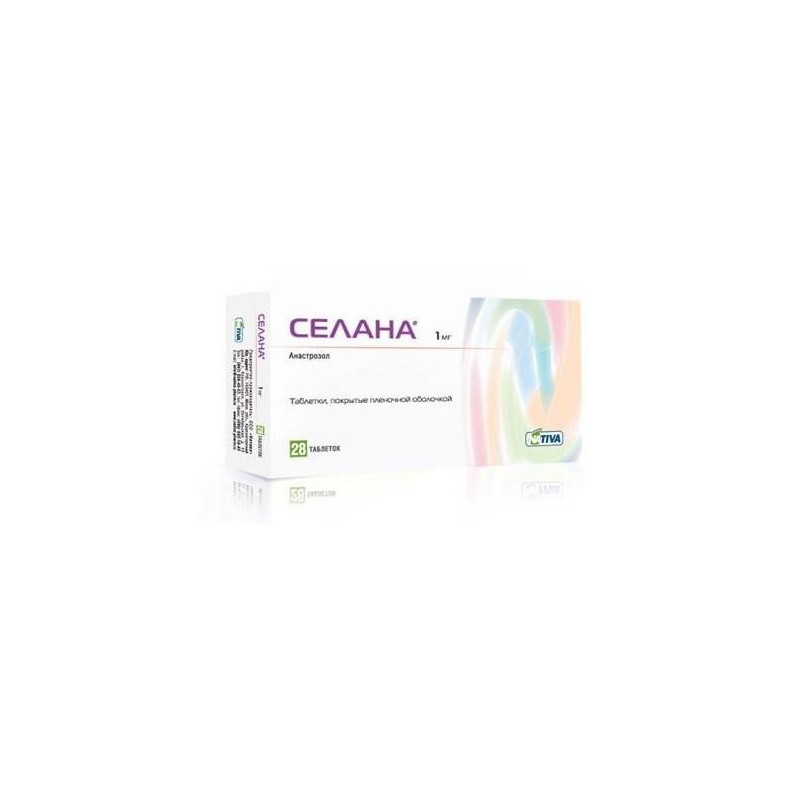



 All payments are encrypted via SSL
All payments are encrypted via SSL
 Full Refund if you haven't received your order
Full Refund if you haven't received your order
Postmenopausal breast cancer.
Film Coated Tablets
1 pill contains:
active substance: Anastrozole 1 mg,
Excipients:magnesium alumometasilicate - 9 mg; croscarmellose sodium - 3 mg; colloidal silicon dioxide - 3 mg; Magnesium stearate - 0.5 mg; ludipress (in terms of components: lactose monohydrate - 77.7 mg; povidone - 2.9 mg; crospovidone - 2.9 mg) - 83.5 mg
film cover: Opadry II white 85F48105 (polyvinyl alcohol - from 35 to 49%, talc - from 9.8 to 25%; macrogol 3350 - from 7.35 to 35.2%, titanium dioxide - from 15.15 to 30% ) - 5 mg
Anastrozole is a highly selective non-steroidal aromatase inhibitor. Aromatase is an enzyme with which in postmenopausal women, androstenedione in peripheral tissues is converted into estrone and further into estradiol. Anastrozole has antitumor activity against estrogen-dependent breast tumors in postmenopausal women. In the postmenopausal period, the drug in a daily dose of 1 mg causes a decrease in the concentration of estradiol by 80%.
Anastrozole does not possess progestogenic, androgenic and estrogenic activity.
Anastrozole in a daily dose of up to 10 mg has no effect on the secretion of cortisol and aldosterone (therefore, the use of the drug does not require substitution administration of corticosteroids).
Suction
After oral administration, anastrozole is rapidly absorbed from the gastrointestinal tract.Maximum concentration (Cmax) in plasma is reached within 2 hours (on an empty stomach). Food slightly reduces the rate of absorption, but not its degree and does not lead to a clinically significant effect on the equilibrium concentration of the drug in plasma with a single daily dose.
Distribution
Anastrozole is associated with plasma proteins by 40%. After 7 days of taking the drug, approximately 90 - 95% of the equilibrium concentration of anastrozole in plasma is reached. There is no information about the dependence of pharmacokinetic parameters on time and dose.
Metabolism
Anastrozole is metabolized by N-dealkylation, hydroxylation and glucuronization. Triazole, the major metabolite detected in plasma, does not inhibit aromatase.
Removal
Anastrozole is eliminated slowly, the half-life (T1/2) is 40 - 50 hours.
Anastrozole and its metabolites are excreted mainly in the urine. Less than 10% of the dose is excreted in the urine unchanged within 72 hours after taking the drug. Pharmacokinetics in special clinical situations
The determined clearance of anastrozole after oral administration in patients with cirrhosis of the liver or impaired renal function does not differ from that determined in healthy people.
Anastrozole pharmacokinetics does not depend on age in postmenopausal women.
Insideswallowing whole and squeezing water.
It is recommended to take the drug at the same time of day.
Adults, including elderly patients, the drug is prescribed 1 mg 1 time per day, for a long time. If there is evidence of disease progression, the drug should be discontinued. As adjuvant therapy, the recommended duration of treatment is 5 years.
Patients with mild and moderate renal failure do not require dose adjustment.
Patients with mild liver failure do not require dose adjustment.
Osteoporosis, hypercholesterolemia, lactase deficiency, lactose intolerance, glucose-galactose malabsorption (in the medicinal form of the drug contains lactose), coronary heart disease, impaired liver function.
In case of uncertainty of the patient's hormonal status, the condition of the menopause must be confirmed by additional biochemical studies.
The safety of using anastrozole in patients with moderately impaired liver function has not been established.
Anastrozole should not be used simultaneously with estrogen.
Influence on ability to drive motor transport and control mechanisms
During the period of treatment should not perform work that requires a high concentration of attention and quick psychomotor reactions.
Anastrozole reduces the effectiveness of estrogen.
Clinical studies have shown that with the simultaneous use of anastrozole with antipyrine and cimetidine, drug interaction due to the induction of microsomal liver enzymes is unlikely.
On the part of the endocrine system: "hot flushes", vaginal dryness and thinning hair.
Gastrointestinal:anorexia, nausea, vomiting, diarrhea. In patients with advanced breast cancer in most cases with metastases to the liver, there was an increase in GGT level, more rarely - alkaline phosphatase.
From the side of the central nervous system:asthenia, drowsiness, headache.
Metabolism:a slight rise in total cholesterol.
Allergic reactions:skin rash.
